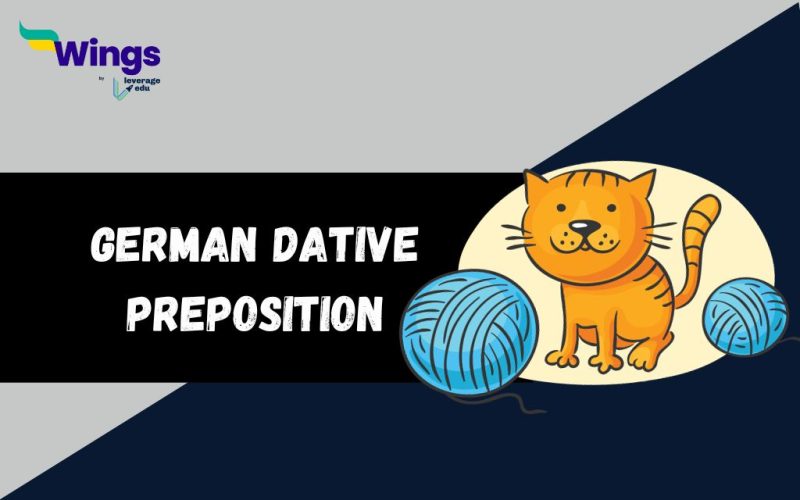Are you interested in learning German? You need to learn about dative prepositions. Most of the dative prepositions in German are in the form of common vocabulary, for instance, nach (after, too), von (by, of), and mit (with). It’s hard to speak German without them. Dative prepositions imply the dative case and are mostly followed by a flavours noun or an object in the dative case. On the other hand in English, prepositions act as an object of the preposition and all the prepositions follow the same case. On the other hand in German, prepositions are of numerous “flavours,” out of which one such kind of German preposition is the Dative Prepositions.
This Blog Includes:

What are Dative Prepositions in German?
Dative prepositions are words that show the relationship between an action and the indirect object in a sentence. They are also responsible for conveying a sense of direction or purpose. Dative prepositions include words such as “aus” (out of), “mit” (with), and “nach” (to/after). In German, for example, “Ich gehe mit Freunden” means “I am going with friends,” whereas “mit” defines companionship. Similarly, in English, “I gave a gift to her” is an example of the use of the dative preposition “to” indicating the recipient. Dative preposition ensures language precision by specifying the indirect object of an action, resulting in grammatical accuracy and effective communication skills.
Also Read: Pictures for Preposition: Master the 4 Types through Visuals [PDF Available]
Dative Preposition Usage With Examples
Here is the list of dative prepositions in German and their meanings in the English Language that refer to the indirect object in the sentence.
| German Preposition | English Translation | Examples in German and English |
| bei | at, near, with | Ich bin bei meiner Familie. (I am with my family.) |
| mit | with | Ich esse mit meinen Freunden. (I am eating with my friends.) |
| von | from, of | Das ist das Auto von meinem Vater. (That is the car of my father.) |
| zu | to | Ich gehe zu meinem Freund. (I am going to my friend.) |
| gegenüber | across from, opposite | Die Bäckerei ist gegenüber dem Park. (The bakery is across from the park.) |
| seit | since | Ich lerne seit dem letzten Jahr Deutsch. (I have been learning German since last year..) |
| aus | out of, from | Er kommt aus dem Haus. (He comes from the house.) |
| nach | to , after | Wir gehen nach Hause. (We are going home.) |
| auBer | except for, besides | Ich mag alle Früchte, außer Bananen” (I like all fruits except bananas.) |
Also Read: Exciting Blog on Nouns
Exercises Based on Dative Prepositions
Instruction: Fill in the blanks with the Dative Prepositions.
- Der Hund liegt _____ dem Sofa.
- Ich gebe das Geschenk _____ meiner Schwester.
- Wir gehen _____ dem Markt einkaufen.
- Das Buch steht _____ dem Regal.
- Sie hilft mir _____ den Hausaufgaben.
- Der Kaffee steht _____ der Tasse.
- Die Blumen stehen _____ dem Fenster.
- Er antwortet _____ dem Lehrer.
- Die Kinder spielen _____ dem Park.
- Die Lampe hängt _____ dem Tisch.
Explore this blog: Abstract Nouns: Definition, Examples and Usage
Answers Based on Dative Prepositions
Match your exercise with the solved answers.
- Der Hund liegt vor dem Sofa.
- Ich gebe das Geschenk meiner Schwester.
- Wir gehen zum Markt einkaufen.
- Das Buch steht im Regal.
- Sie hilft mir bei den Hausaufgaben.
- Der Kaffee steht in der Tasse.
- Die Blumen stehen vor dem Fenster.
- Er antwortet dem Lehrer.
- Die Kinder spielen im Park.
- Die Lampe hängt über dem Tisch.
Related Posts
FAQs
The eight dative prepositions are bei, mit, von, zu, gegenüber, seit, aus, Nach.
The dative denotes possession and is used with the verb “to be”.
If something is in a fixed position we use the dative case. If the thing is moving around, or it is in action we use the accusative.
We hope this blog on dative prepositions provided you with all the necessary information.To advance your grammar knowledge and read more informative blogs, check out our Learn English page and don’t forget to follow Leverage Edu.
 One app for all your study abroad needs
One app for all your study abroad needs














 45,000+ students realised their study abroad dream with us. Take the first step today.
45,000+ students realised their study abroad dream with us. Take the first step today.

